Launch a Points Program Customers Actually Love
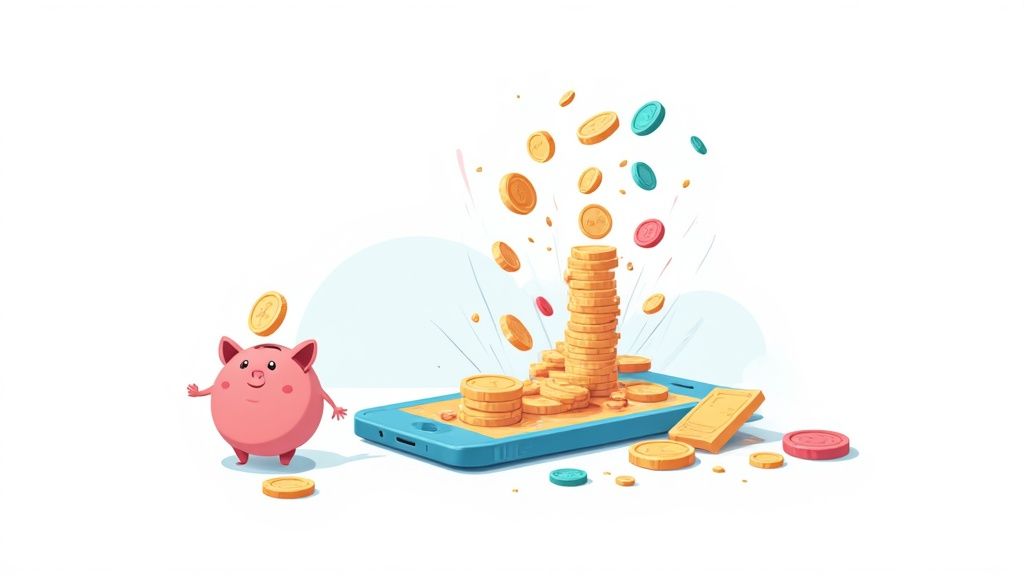
Ever find yourself going back to the same coffee shop, not just for the caffeine, but because you're this close to earning a free latte? That's a points program in action.
At its heart, a points program is a simple thank you. Businesses reward you for sticking around, usually for things you’re already doing, like making a purchase. It’s like a digital piggy bank where every transaction adds a little something that you can cash in later for discounts, freebies, or other cool perks. It’s a classic, straightforward way to build loyalty and keep people coming back.
Deconstructing the Points Program
So, what's really going on with that coffee shop card or the airline miles you're hoarding? It all boils down to a simple, powerful exchange: you give a brand your business, and they give you something valuable in return. This back-and-forth creates a positive loop that makes you feel connected to the brand.
But it’s about more than just transactional rewards. A well-run program can turn casual customers into a real community of advocates. When people feel seen and appreciated for their loyalty, they don't just buy from you; they become genuine fans. It's a fundamental shift in the customer relationship, and it works. That's why over 90% of global companies have some kind of loyalty program. If you're curious about the numbers, you can discover more insights about loyalty program statistics and see just how common this strategy has become.
The Core Components of a Points Program
While every program has its own flavor, they all share a few key ingredients that make them work.
Earning Mechanism: This is the how. How do people rack up points? Most often, it's tied to spending (think 10 points for every dollar), but smart programs also reward other actions like signing up for an email list, sharing on social media, or writing a review.
Redemption Options: This is the fun part—the payoff! What can you actually get with your hard-earned points? The options can be anything from a simple discount on your next purchase to exclusive merch, early access to new products, or even tickets to a special event.
Value Proposition: The rewards have to feel worth it. It’s a simple cost-benefit analysis for the customer. If someone has to spend a thousand dollars just to get a $5 coupon, they’re going to lose interest fast. The perceived value of the reward has to make the effort feel justified.
A successful points program isn't just about giving stuff away. It's about creating a system where both the customer and the business feel like they're winning. The customer gets rewarded for their loyalty, and the business gets sustained engagement and valuable data.
Why Your Business Needs a Points Program
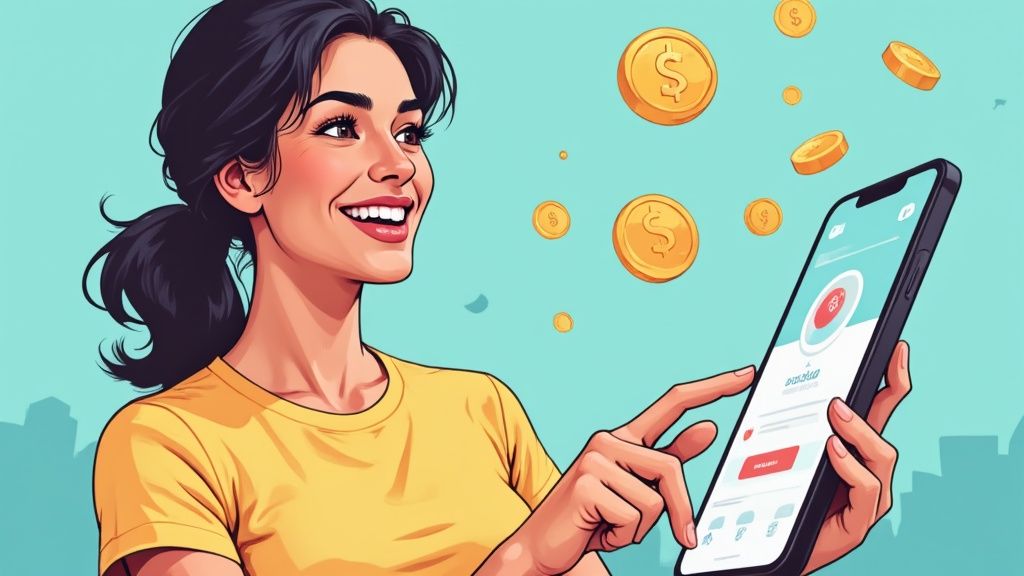
So, why bother with a points program? It’s not just a nice-to-have or some fluffy marketing gimmick. It's a rock-solid business strategy that hits one of the toughest challenges head-on: keeping customers coming back.
Think about it. We all know it costs way more to find a new customer than to keep an old one happy—sometimes five times more. A points program gives your existing customers a real, tangible reason to stick with you. Rewarding them for their business builds a bond, turning them from one-time buyers into loyal fans.
This loyalty creates a simple but powerful loop. When someone sees they're just a few points away from a reward, they're much more likely to add one more thing to their cart or come back sooner. It's a small psychological nudge that can seriously boost your revenue over time.
Boosting Customer Lifetime Value
The real magic of a points program is how it jacks up your Customer Lifetime Value (CLV). That's just a fancy term for the total amount of money a single customer is likely to spend with you over their lifetime. When you get people to buy again and again, you're not just making a sale; you're building a more valuable, long-term relationship.
And it’s not just a theory—businesses are betting big on this. The global loyalty management market, currently valued at $13.31 billion, is expected to explode to $41.21 billion by 2032. That's a massive trend, and you can read the full research on the loyalty market's growth to see just how big it is.
A well-designed points program transforms transactions into relationships. It shifts the focus from one-off sales to building a sustainable, long-term community that grows with your business.
Gaining Invaluable Customer Insights
Beyond the sales, a points program is secretly a data goldmine. Watching how people earn and spend their points tells you exactly what they like and what motivates them. It’s like getting a direct look into their brain.
With this data, you can do some really smart things:
- Personalize Marketing: Stop guessing and start sending offers you know people will actually want based on what they’ve bought before.
- Identify Top Customers: Find your VIPs and treat them like gold. These are your biggest brand ambassadors.
- Optimize Your Offerings: See which products are flying off the shelves and which rewards get people excited. Then, double down on what works.
This isn't about being creepy; it's about being relevant. When you understand your customers, you can build an experience that feels like it was made just for them, creating a much stronger business in the process.
Exploring Different Types of Points Programs
Points programs aren't a one-size-fits-all solution. Think of them like tools in a toolbox—you need to pick the right one for the job. The best approach for your brand really boils down to what you're trying to accomplish. Are you chasing repeat sales, building an exclusive club, or creating a super-engaged community?
Let's break down some of the most common models you'll run into.
The Classic Earn-and-Burn Model
This is the bread and butter of loyalty programs. It’s simple, direct, and everyone gets it right away. Customers perform an action—usually making a purchase—and they get points. Once they have enough points, they "burn" them for a reward, like a discount or a free product.
The beauty of the earn-and-burn system is its simplicity. There’s no complex math or hidden rules. It’s a clean, direct value exchange that works incredibly well for businesses focused on one thing: getting customers to come back again and again.
Tiered Programs That Drive Aspiration
Ready to add a little friendly competition? Tiered programs are all about creating levels of status that users can climb. Think of it like a video game where you level up. Customers unlock new tiers by hitting certain milestones, like spending a certain amount or engaging with your brand consistently over time.
Each tier comes with better and better perks. It often looks something like this:
- Bronze Tier: The entry level. You might get a small birthday bonus or a basic discount.
- Silver Tier: You've shown some loyalty. Now you get all the Bronze perks, plus early access to new products and a slightly better points-to-dollar ratio.
- Gold Tier: The VIP lounge. You get everything from the lower tiers, plus exclusive event invites, free shipping on everything, and maybe even a dedicated support line.
This model is pure genius because it taps into our natural desire for status and recognition. Airlines perfected this, creating an army of loyal flyers chasing that next status level. It makes your most valuable customers feel special and gives everyone else something to shoot for.
The core idea is that the more a customer engages, the more valuable their rewards become, which keeps them coming back.
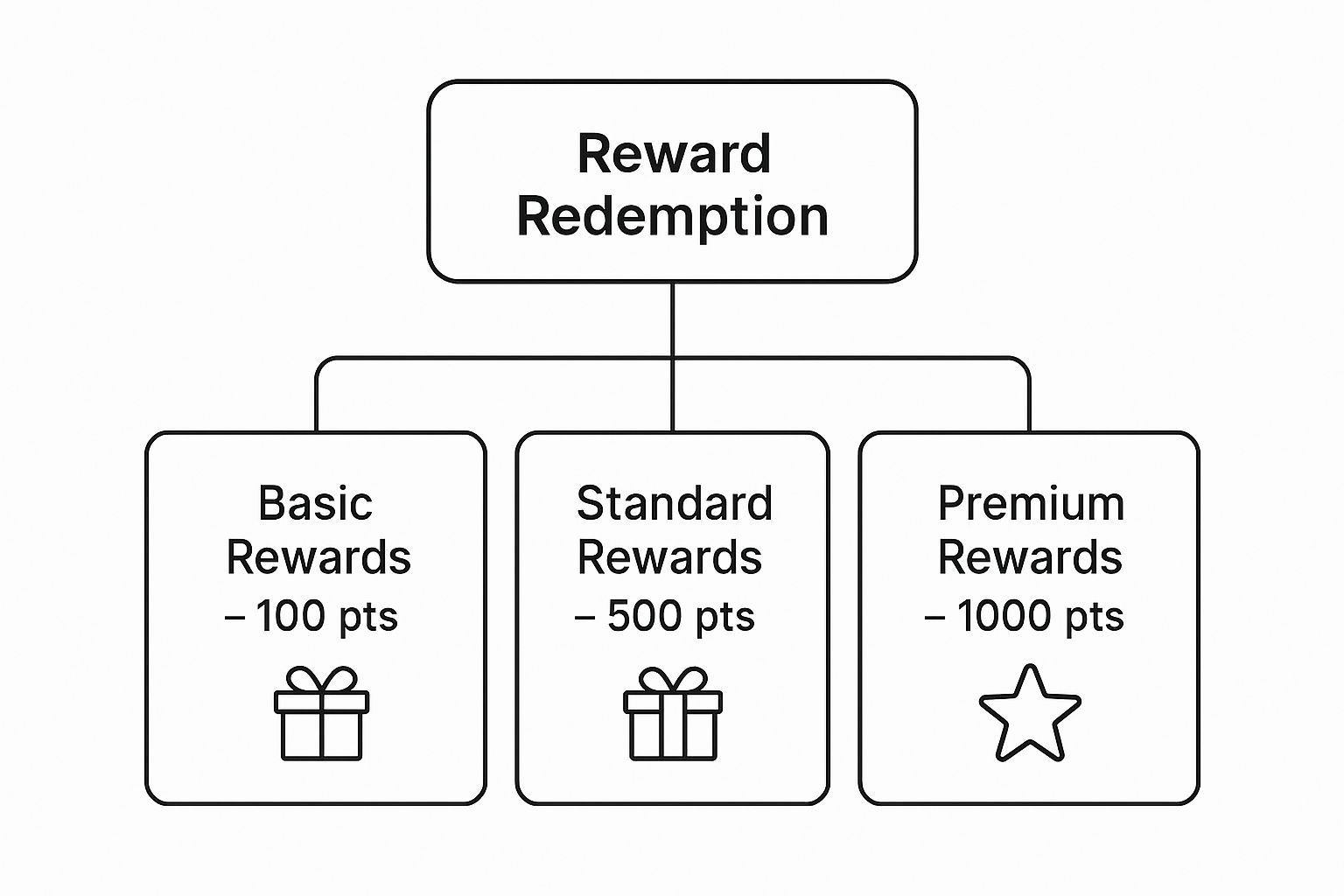
As you can see, offering bigger and better rewards for higher point totals is a great way to encourage users to save up and stay engaged for the long haul.
Gamified Programs for Deeper Engagement
Gamified programs take loyalty beyond just spending money. They turn interacting with your brand into a fun, engaging experience. Instead of just rewarding transactions, you start rewarding behaviors by incorporating things like challenges, badges, and leaderboards.
By adding elements of play, a gamified program transforms routine actions into exciting achievements. It encourages a wider range of behaviors beyond just spending, building a more active and connected community.
For example, you could award bonus points for completing a "quest," like following your brand on three social platforms, referring a friend, and leaving a review. Suddenly, you're not just a company they buy from; you're a community they're a part of. This is a fantastic way to foster a real connection and encourage the kinds of interactions that build a stronger brand.
Comparing Points Program Models
To make it even clearer, here’s a quick breakdown of how these different models stack up against each other.
| Program Type | How It Works | Best For | Key Benefit |
|---|---|---|---|
| Earn-and-Burn | Users earn points for specific actions (like purchases) and redeem them for rewards. | E-commerce & retail; driving repeat purchases. | Simplicity and immediate value. |
| Tiered | Users unlock escalating levels of rewards and status based on long-term loyalty. | Travel, hospitality, and high-value brands. | Fosters aspiration and VIP status. |
| Gamified | Users complete challenges, quests, and tasks to earn points, badges, and rewards. | Community-focused brands & Web3 projects. | Drives deep, multi-faceted engagement. |
Ultimately, the right model depends on your audience and your goals. You can even mix and match elements from each to create something totally unique for your community.
Best Practices for a Program Customers Will Love
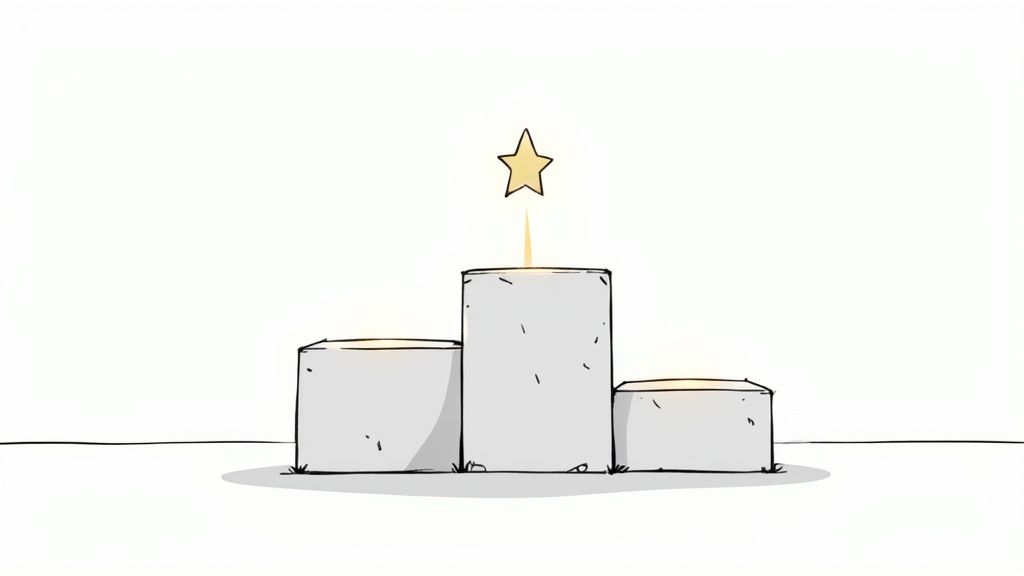
Getting a points program off the ground is one thing. But creating one that people actually get excited about? That’s where the real magic happens. A truly great program feels less like a marketing gimmick and more like a genuine “thank you” for being a customer.
The secret is to build a system that’s simple, valuable, and feels like a natural part of your brand.
It all boils down to creating a smooth, frictionless experience. If people have to jump through a bunch of hoops to sign up or the rules are a total headache to figure out, they’ll bail before they even earn their first point. Your program needs to be so straightforward that a new user gets it in seconds.
Make Rewards Simple and Valuable
The heart of any loyalty program is the rewards. They have to be things people actually want, and they need to feel within reach. A reward that feels impossible to earn is just frustrating, but a boring reward won't motivate anyone to do anything.
So, how do you strike that perfect balance? Stick to these principles:
- Clarity is Key: Users should know exactly what they need to do to earn points and what those points get them. Think "10 points for every $1 spent"—it’s clean, simple, and much better than some complicated formula.
- Offer a Mix of Rewards: Don't just offer one big prize. Give people a range of options, from small, easy-to-get wins (like a quick discount) to bigger, aspirational rewards (like exclusive merch) that encourage them to stick around.
- Keep It Attainable: Make sure the first reward isn't a million miles away. That initial win hooks the user, proves the program has real value, and gets them excited to keep going.
You’re trying to create a fun feedback loop where earning and redeeming points feels good, not like a chore. And this stuff works. Nearly 70% of brands report a jump in customer engagement after launching loyalty programs, and 58% see more repeat purchases. If you're curious, you can discover more insights about loyalty program trends and see the full impact for yourself.
Personalize the Experience
The days of one-size-fits-all are over. The best programs out there use customer data to make the whole journey feel personal. When you understand how a user behaves, you can start sending them offers and rewards that actually feel relevant.
A truly great points program makes each member feel seen and valued. Personalization isn't just about using their first name in an email; it's about anticipating their needs and rewarding them in ways that matter to them specifically.
For instance, you could send bonus point offers for products someone has browsed before or create special challenges based on their past activity. It’s that next level of detail that shows you’re paying attention.
This turns your points program from a generic system into a real relationship. This same idea of rewarding specific actions is a core concept you can use when you build a winning cryptocurrency affiliate program.
By focusing on simplicity, real value, and a personal touch, you’ll build a program that doesn't just keep customers around—it turns them into your biggest fans.
Launching Your Web3 Points Program With Domino
So, we all know how powerful a good old-fashioned points program can be. But what if your points could do more? What if they weren't just a number tucked away in a company database, but actual digital assets your community members could truly own?
Welcome to the next evolution of loyalty: the Web3 points program.
This new model taps into blockchain technology to create a system that’s way more transparent, flexible, and engaging. Instead of points being stuck inside one brand's little world, Web3 points can be designed as transferable assets. This opens up a whole universe of possibilities, from cross-platform utility to genuine user ownership. And this is exactly where Domino comes in, making this sophisticated approach surprisingly easy to pull off.
With Domino, you can build a truly modern loyalty system without ever touching a line of code. The platform gives you all the tools you need to design, launch, and manage a program that connects everything your community does, both on-chain and off.
Defining Your Earning Rules and Quests
First things first: you have to decide what actions you want to reward. This is where Domino really shines by letting you create "quests"—specific tasks users can complete to rack up points. And we're talking about way more than just rewarding purchases here.
You can get creative and build out a whole set of quests that not only grow your community but also hit your key growth targets. Think about rewarding things like:
- Social Engagement: Give out points for following you on X (formerly Twitter), jumping into your Telegram channel, or even just reacting to a Discord announcement.
- Content Creation: Encourage user-generated content by rewarding people for making a video review or writing a blog post about your project.
- On-Chain Actions: You can directly incentivize blockchain interactions, like staking tokens, minting an NFT, or casting a vote on a governance proposal.
This screenshot gives you a peek at Domino's quest-builder. It's super intuitive—you can easily define tasks and set the rewards.
The platform even has a library of templates to get you started, so you can quickly customize quests that are a perfect fit for your community's goals.
Setting Up Your Rewards Catalog
Okay, so your community is earning points. Now what? They need cool stuff to spend them on. A killer rewards catalog is the engine that drives your entire program, giving people a real reason to stick around and stay engaged.
In a Web3 world, rewards aren't just about discounts. They can be exclusive digital collectibles, early access to new features, or even a say in how your ecosystem is run. True ownership is the ultimate reward.
Think bigger than the usual perks. With a Web3 points program, you can offer unique, high-value rewards that traditional systems just can't compete with:
- NFTs and Digital Collectibles: Offer up some limited-edition NFTs that can only be claimed with points.
- Token Airdrops: Give your most loyal members an exclusive ticket to future token distributions.
- Allowlist Spots: Guarantee top point-earners a spot for your next big mint or sale.
By mixing both on-chain and off-chain rewards, you create a dynamic system that has something for everyone. If you're curious about how tokenomics can supercharge this kind of engagement, our guide on staking your claim in the Web3 ecosystem dives deeper into similar reward mechanisms.
Domino makes it a breeze to set up and automatically deliver these rewards, turning your points program into a powerful, self-sustaining community engine.
Measuring Success and Scaling Your Program
So you’ve launched your points program. Congrats! But don't pop the champagne just yet. The real work is just getting started. Now it's all about tracking what’s working, figuring out what isn't, and planning your next move.
To do that, you need to be looking at the right numbers. Forget vanity metrics like the total number of sign-ups—they don't tell you much. We need to focus on the Key Performance Indicators (KPIs) that actually show if your program is making a difference to your bottom line. When you're looking at your program's performance, it's essential to know how to measure marketing ROI to make sure your investment is paying off.
Key Metrics That Actually Matter
To get a real pulse on how your program is doing, you need to watch a few core metrics. These numbers will show you not just if people are signing up, but how their behavior is changing because of your program.
- Redemption Rate: This is a big one. It's the percentage of earned points that people are actually cashing in for rewards. If this number is low, it could be a sign that your rewards aren't exciting enough or they're just too hard to get.
- Repeat Purchase Frequency: Are members coming back to buy more often than non-members? This is a direct line to understanding if your program is building real loyalty and encouraging repeat business.
- Customer Lifetime Value (CLV): This is the holy grail. Are your program members ultimately more valuable to your business over time? Comparing the CLV of members to non-members will give you a crystal-clear answer.
A successful points program doesn't just give things away; it actively changes customer behavior. If your metrics show increased purchase frequency and a higher CLV for members, you’re on the right track.
Once you have a good grip on this data, you can start thinking about scaling. And scaling isn't just about throwing more users into the mix. It's about adding depth and making the program even more engaging. Listen to what your members are saying, then use that feedback to roll out new reward tiers or launch special campaigns, like offering double points for a limited time.
For a deeper dive into analyzing program performance, check out our guide on how to measure marketing ROI. By constantly looking at the data and evolving what you offer, your points program will become a powerful asset that grows right alongside your community.
Got Questions About Points Programs? Let's Answer Them.
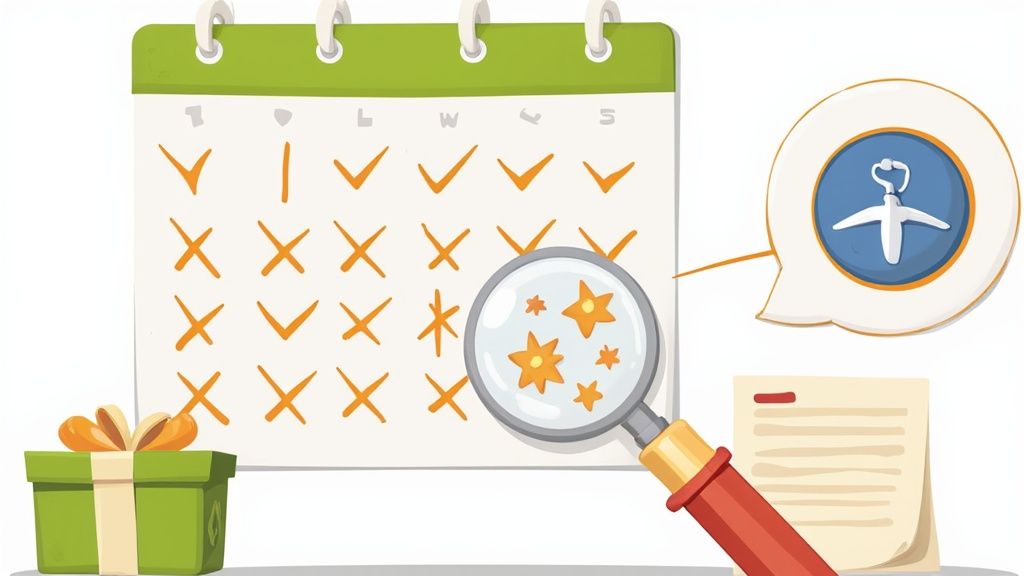
Even with the best game plan, a few questions are bound to pop up before you launch your points program. Let’s tackle some of the most common ones head-on so you can move forward with confidence.
How Much Is This Going to Cost?
Honestly, the cost can be all over the map. It really depends on what you're trying to do. You can find some simple, off-the-shelf software with free starter plans for the basics, which is great if you're just dipping your toes in.
On the other end, a fully custom-built or Web3-integrated system will naturally require a bigger budget. The trick is to find a tool that fits your goals and your wallet. Platforms like Domino are built to make even sophisticated Web3 programs manageable and affordable.
What are the Classic Mistakes I Should Avoid?
Two things sink programs faster than anything else: making them way too complicated and offering rewards nobody actually wants. If your users need a manual to figure out how to earn points, or if the prizes feel cheap, they’ll check out immediately.
The secret sauce for a great points program is keeping it simple, generous, and crystal clear. Complexity kills engagement. Your goal should be a smooth experience that offers obvious value.
Another common slip-up is poor communication. You can build the best program in the world, but if you don't talk about it, people will forget it exists. Keep it on their radar with regular reminders and updates.
How Long Until I Actually See Results?
You'll probably get a nice little spike in engagement right after you launch—that's the easy part. But the real magic of a points program is a slow burn; it’s all about long-term value.
Give it about three to six months to see real, meaningful shifts in behavior, like customers sticking around longer or buying more often. Patience and consistent effort are your best friends here.
Ready to build a Web3 points program your community will love? With Domino, you can design and launch powerful, no-code quests in minutes. Start building for free.
Level Up Your dApps
Start using Domino in minutes. Use automations created by the others or build your own.
